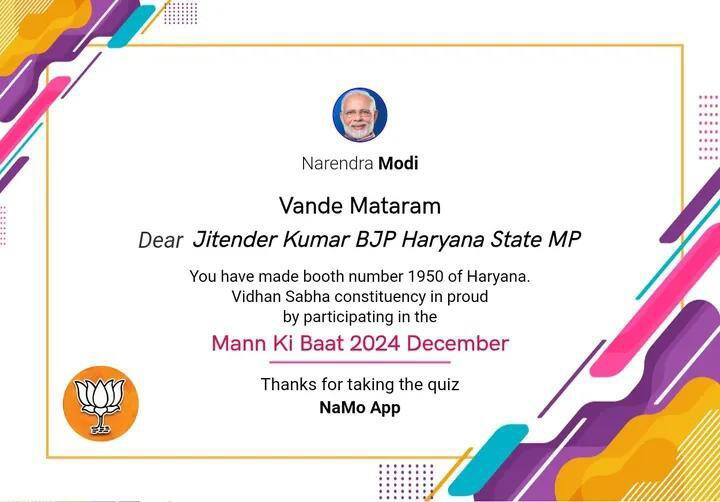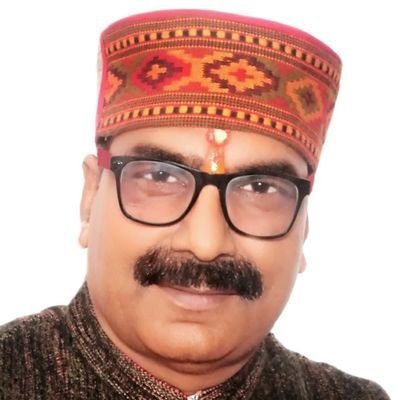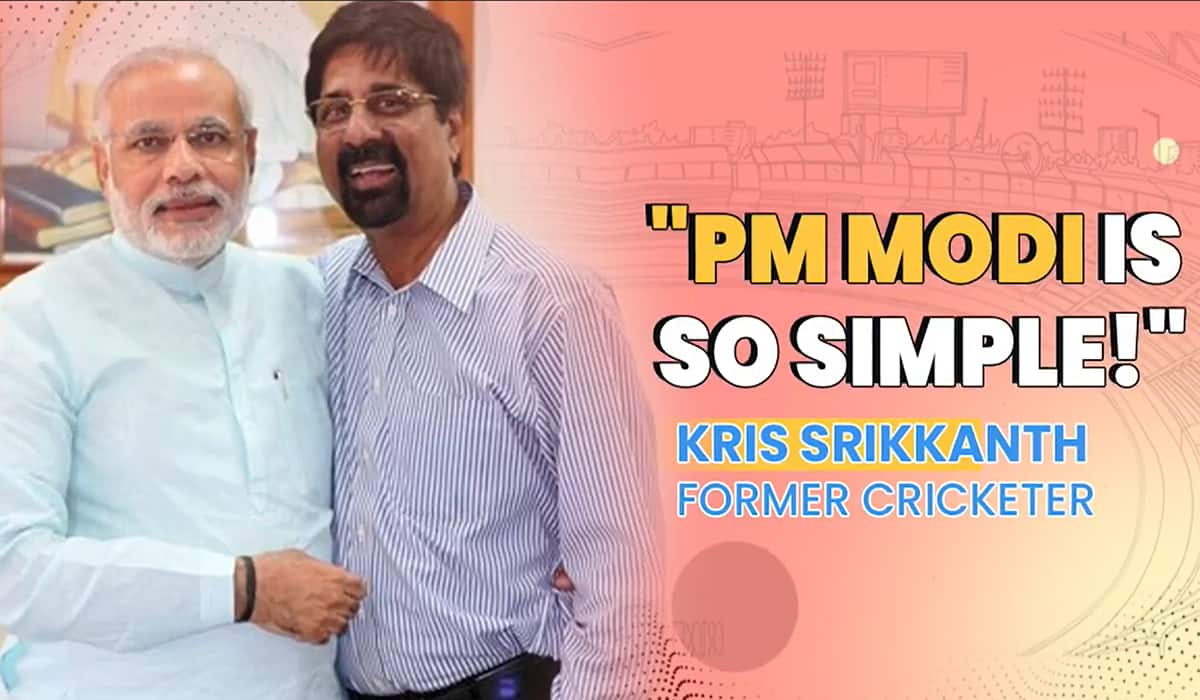“The BJP’s journey is one of creating a ray of hope among the people of India. Wherever the BJP has reached today is not due to one person but due to hardwork, sweat and sacrifices of generations of Karyakartas. For us the Nation will always be above the Party. BJP will keep moving ahead with our motto of India first!”
Narendra Modi to Karyakartas during Karyakartas Mahasammelan in Ahmedabad on 6th April 2013.
Narendra Modi addressing BJP Karyakarta Mahasammelan on Party’s 33rd Sthapana Divas
Prime Minister Narendra Modi, who started his journey as a party worker rose to the topmost post in the country, because of his almost virtuoso like organizational sense and his keen ability to deconstruct and efficiently construct any job given to him. Even when he was a party worker he was noticed for his ability to deliver on any organizational role assignment. The party seniors sent him to troubleshoot in areas that were crucial to the growth of the party. Every time he was given a responsibility in the party – whether at organizing a rally or an election campaign in a hostile region – he always exceeded expectation.
Till date he stresses on the importance of focusing on the organizational role of workers at every level and speaks about it often.
Narendra Modi made the speech above on a sultry September afternoon in Ahmedabad, when he took stage to address Karyakartas (workers) of the Bharatiya Janata Yuva Morcha (BJYM), which is the youth wing of the BJP. The core of his speech was a message on the importance of booth management:
“Booth management is very important during elections. Just like you cannot win a battle without winning a fort, you cannot win an election without securing a victory at the polling booth. Winning at the polling booth is the real test of an election.”
Narendra Modi addressing BJYM
In the same speech he said that it is important that the party workers stand shoulder to shoulder with the people during times of happiness and sadness and develop a personal connect with them.
Today, the world knows Narendra Modi as a dynamic developmental figure who has transformed the landscape of his home state Gujarat. But before he earned the reputation of being a superlative organiser with the Midas Touch, he transformed every area he worked into a success story for the BJP.
Narendra Modi - Man with the Midas Touch
For a man you are used to seeing sitting in a swanky chamber surrounded by the who’s who from India and the world, you would be surprised to know that Narendra Modi’s first job in the RSS was to mop the floor at the RSS Headquarters in Ahmedabad!
His ‘duties’ included fetching milk in the morning and keeping the office premises clean. He would even wash clothes for senior Pracharaks, out of respect.
Despite Modi’s reluctance to keep away from the rough and tumble of electoral politics he was asked by the Sangh leadership to join the BJP in 1987 as General Secretary. Since then there has been no looking back, as he won election after election and even helped others win elections for the BJP.
Municipal Elections: Small is Big
On joining the BJP in 1987, Narendra Modi’s first test was the Municipal Elections in Ahmedabad that very year. Through the early 1980s the BJP tasted success in the Rajkot and Junagadh corporations and even won a few seats in the Assembly, but Ahmedabad Municipal Corporation (AMC) remained the prize catch for a party seeking to establish a foothold in the state. The Congress that was firmly in the saddle in the Parliament, Vidhan Sabha and almost every Panchayat/Corporation in Gujarat was heavily discredited, but their strong-arm tactics made them a Party hard to beat.
Taking the challenge head-on, Narendra Modi covered the entire city and worked tirelessly to ensure a victory for the BJP. Finally, the results were just what the BJP wanted. The Party became the ruling party in the AMC giving it an opportunity to serve people and expand its base in the years to come.
The BJP remained the dominant force in the AMC till 2000. Ironically, this was the first Municipal Election since 1987 when Narendra Modi was not in Gujarat and working elsewhere.
Success in the Vidhan Sabha: The Lotus Shines in Gandhinagar
Under the leadership of Madhavsinh Solanki and his KHAM coalition, the Congress won 141 seats with a voteshare of 51.04% in the 1980 Assembly Elections. The BJP won only 9 seats. Riding on the coattails of a new social coalition along with a sympathy wave after Mrs. Indira Gandhi’s assassination, Solanki led the Congress to another resounding victory winning 149 seats and a voteshare of 55.55%. For the BJP, it was disappointment once again. The party had to be content with 11 seats with a marginal improvement in voteshare (14.96%).
However, the Congress lacked any clear policy goal and all they could do was play politics around reservations and create/destroy social coalitions. The years between 1985 and 1988 witnessed severe droughts. The social fabric of Gujarat wastorn apart by several bomb blasts.
Narendra Modi welcomed to Gujarat in 1990s
As the Assembly Elections of 1990 approached, the mood was vehemently anti-Congress but the strong-arm tactics of the Party persisted. Narendra Modi had his task cut out - to build a strong organisation that would complement the political leadership of the party to secure a mandate from the people.
On 27th February 1990, after a decade of Congress rule, Gujarat elected a new Vidhan Sabha. The results put the Janata Dal under Chimanbhai Patel at pole position with 70 seats and 29.36% of the votes. The BJP was close second with 67 seats and 26.69% votes. From a party that barely had a presence, the BJP emerged as a formidable force that was here to stay.
Narendra Modi, Keshubhai Patel and other leaders listening to the speech of L. K. Advani in 1990s
The second litmus test faced by the Gujarat BJP when Narendra Modi was very active as an organiser in the state unit was the 1995 Assembly Elections. The 1995 elections was the first time that the BJP contested all 182 Vidhan Sabha seats. It was also the first time it was contesting more seats than the Congress. The people of Gujarat gave a thumping victory to the BJP as the party won 121 seats. BJP’s voteshare shot upto 42.51%. For the Congress, it was a disappointing run and they managed only 45 seats. Narendra Modi successfully strengthened the Organisation and exposed several cracks in the Congress armour.
The BJP formed the Government but the problems were far from over. There was intense factionalism within the BJP leaders in Gujarat and finally the Party lost its grip on power in 1996. By this time Narendra Modi was already in Delhi, working as the National Secretary of the BJP.
Riding on the betrayal of their own leaders who formed splinter parties and joined hands with the Congress in 1996, the BJP returned to power in 1998 but by 2001 again the shadow of gloom was large. Successive natural calamities from flood, cyclone, drought and a deadly earthquake in Kutch combined with poor relief work alienated people from the BJP. There were allegations of corruption in the cooperative sector. In these trying times, Narendra Modi was asked to become the Chief Minister of Gujarat on 7th October 2001. A man who had never dreamt of power or office was given this responsibility with a single aim- to enhance the prestige of the faltering BJP government in Gujarat. With elections scheduled for March 2003, Narendra Modi, again had his task cut out.
The unfortunate events in Godhra and the rest of Gujarat convinced Narendra Modi that the state neededa new government to carry forward the process of healing and development for the state. He was also convinced that the BJP was the right Party to do so. That is why he dissolved the Assembly early and Elections were declared in December 2002.
During the campaign, Narendra Modi became the most vilified figure in Indian politics. Political pundits derided him and pollsters called the Election in favour of the Congress. He campaigned hard but unlike earlier times, he was the face of the campaign – a strategy he adopted again during the Lok Sabha elections. Narendra Modi covered the entire state and spread the message of hope.
The result was a spectacular win for the BJP, which won 127 seats and a vote share of 49.85%. The Congress won only 51 seats.
From 2002-2007, Narendra Modi ensured a clean and development oriented Government for Gujarat with the state developing in leaps and bounds. But as more development took place in Gujarat, more the frustration grew in the opposition. In 2007, as the Assembly Elections approached, Narendra Modi again became the target of personal slander. The Congress President described him as a “Merchant of Death” in a campaign full of bitterness. Yet, Narendra Modi stayed away from hate-driven politics and focused on his strengths and the agenda of development. Finally, the BJP won 117 seats and retained a voteshare of 49.12%. The Congress remained under 60 seats winning 59.
https://www.narendramodi.in/360/build.html
Narendra Modi’s most recent electoral victory in Gujarat came in December 2012, when the Party emerged victorious with 115 seats. The people of Gujarat gave him a thumping victory.
During the entire period from 2001 till date, while Narendra Modi has been the Chief Minister, the BJP has won in every round of the Panchayat and Corporation elections.
From 1990 till 2012 a lot changed, but what remained constant was the hardwork, determination and dedication of Narendra Modi, who invigorated each campaign through innovation and ensured the mandate was in favour of the BJP.
Lok Sabha Elections: Maximum Lotuses to Delhi from Gujarat
Narendra Modi’s ability as an organiser also helped the Party send the maximum BJP MPs to Delhi from Gujarat in successive Lok Sabha Elections. In 1984, the BJP won a lone Lok Sabha seat from Gujarat but 5 years later in the 1989 Lok Sabha Elections, the Party tally rose to 12 and in 1991 the tally shot up to 20!
In 1996, 1998 and 1999 the BJP’s tally remained above 20 from Gujarat. Even though he was not in Gujarat during this period, the foundation to this victory was laid by Narendra Modi’s tireless efforts. While he was Chief Minister of Gujarat, the BJP won a majority of seats in the Lok Sabha Elections of 2004 and 2009, from the state.
The Yatras: Putting Nation before Self
As General Secretary in Gujarat, Narendra Modi became the force behind organising the Nyay Yatra in 1987 and the Lok Shakti Yatra in 1989. Both these Yatras became a focal point in the quest for justice for the people of Gujarat, under a repressive and corrupt Congress regime.
Narendra Modi and Murli Manohar Joshi holding Ekta Yatra in 1991
Nationally, Narendra Modi was a key figure in organising the Somnath to Ayodhya Yatra led by Shri LK Advani and the Ekta Yatra led by Dr. Murli Manohar Joshi. The Ekta Yatra was held in the backdrop of the volatile atmosphere in Kashmir created by terrorists, who were disallowing the hoisting of the Tricolour in Srinagar. Before the Yatra began, Narendra Modi inspected all the locations himself.
Narendra Modi joins L. K. Advani’s Janadesh Yatra
L. K. Advani’s Somnath to Ayodhya Yatra
Organising Yatras is never an easy task. From finalizing the route to checking preparedness at every location to ensuring smooth movement, everything is a part of the duty of the organizer. And Narendra Modi performed this role with perfection in those years. As Chief Minister too he undertook several Yatras, the most recent one being the Vivekananda Yuva Vikas Yatra, in 2012, where he travelled across Gujarat and spread Swami Vivekananda’s message among the people.
Narendra Modi initiates Vivekananda Yuva Vikas Yatra
Beyond Gujarat: Success in North India
In 1995, Narendra Modi was sent to Delhi as BJP National Secretary. He was given charge of the states in North India, namely Jammu and Kashmir, Himachal Pradesh, Punjab, Haryana and the Union Territory of Chandigarh. The BJP’s position in all these states was weak. Both Jammu & Kashmir and Punjab had witnessed a turbulent 15 years. If the elections in JK were fraught with discrepancies in 1987, the opposition had boycotted the Punjab elections in 1992. Haryana was in the Congress kitty and in Himachal Pradesh the BJP was routed in the 1993 Assembly elections.
Narendra Modi hoisting Indian Flag in Srinagar in 1992
This is again where Narendra Modi’s keen organizational skills came in handy. In Haryana, where elections were held in mid-1996, the BJP stitched an alliance with Bansi Lal’s Haryana Vikas Party and the alliance formed the Government with 44 seats. Bansi Lal became the Chief Minister. The BJP won 11 out of the 25 seats it contested in. Compare this with 1991, when the party contested in 89 out of the 90 seats and won only 2. A decade ago, it was unimaginable for the BJP to enter into alliances with Bansi Lal and Devi Lal but with immense tact and without compromising the core ideology of the party, these alliances became a reality.
The situation in Jammu and Kashmir was complex – the 1987 elections were held under rather controversial circumstances and Kashmir was under President’s Rule since 1990. When the state went to the people in 1996, the people gave their mandate to Farooq Abdullah’s National Conference with 57 out of the 87 seats. The second highest number of seats went to the BJP. Though the number stood at 8, it was indeed a victory of sorts as the party polled more seats than other parties like the Congress or Janata Dal.
The other state under Narendra Modi’s care, Himachal Pradesh had a different political landscape. While the BJP formed the Government in 1990 with 46 seats out of the total 68 seats, the Government lost in the wake of the Babri Demolition in 1992. When the state voted again in 1993, the BJP was vanquished and won only 8 seats. In 1998, the BJP and the Congress both won 31 seats and the balance of power hung with former telecom Minister Sukhram’s Himachal Vikas Congress, which had 5 MLAs. Narendra Modi played an influential role in winning over Sukhram and forming the Government under a fresh face, Prem Kumar Dhumal. Dhumal went on to become the Chief Minister again in 2007 for a full term albeit with a complete majority.
The success in Punjab was the grandest where the Akali-BJP combine literally swept into power with 93 of the 117 seats between the two parties in the 1997 Vidhan Sabha elections. The BJP contested 22 seats, won 18 and recorded a voteshare of 48.22% in the seats where it contested. A year before, in 1996, Modi spearheaded the BJP’s campaign in the Chandigarh civic polls and delivered a three fourth majority for the BJP. The victory is noteworthy because in the Chandigarh Corporation, there is a proportion of members are nominated by the LG, who was appointed by a non-BJP Government. It was Narendra Modi’s eye for detail that the party picked Satyapal Jain to contest the Chandigarh Lok Sabha seat in 1998 when he defeated Pawan Kumar Bansal.
Narendra Modi and Parkash Singh Badal
Narendra Modi’s performance as an organiser in parliamentary elections is also noteworthy with him having to face three Lok Sabha elections in the six years that he was out of Gujarat. In his first election as the in-charge on these states, the BJP won one seat in JK, four seats in Haryana and was blanked out in Punjab and Himachal Pradesh. However, in 1999, JK sent 2 MPs, Himachal Pradesh 3, Punjab 1 and Haryana 5.
Swearing-in ceremony of Shri Atal Bihari Vajpayee in 1998
Narendra Modi was made the National General Secretary (Organisation) in 1998. The post of General Secretary (Organisation) is a very important position in the organizational structure of the party, which entails coordinating the matters across the entire nation. Previous occupants of this post include Kushabhau Thakre and Sundar Singh Bhandari. He was the General Secretary Organisation in 1999, when the BJP won its highest ever tally of 182 Lok Sabha seats.
In June 2013, for 2014 Lok Sabha Elections and on 13th September 2013, he was named the NDA’s Prime Ministerial candidate.
Narendra Modi declared as NDA’s Prime Ministerial candidate
From cleaning office premises to being a part of election campaigns for the Panchayat to the Parliament, Shri Modi has seen every facet of what it takes to work for a Party Organisation. And, everything he touched attained success! No wonder he is the BJP’s Midas Man.
Disclaimer:
It is part of an endeavour to collect stories which narrate or recount people’s anecdotes/opinion/analysis on Prime Minister Shri Narendra Modi & his impact on lives of people.





































